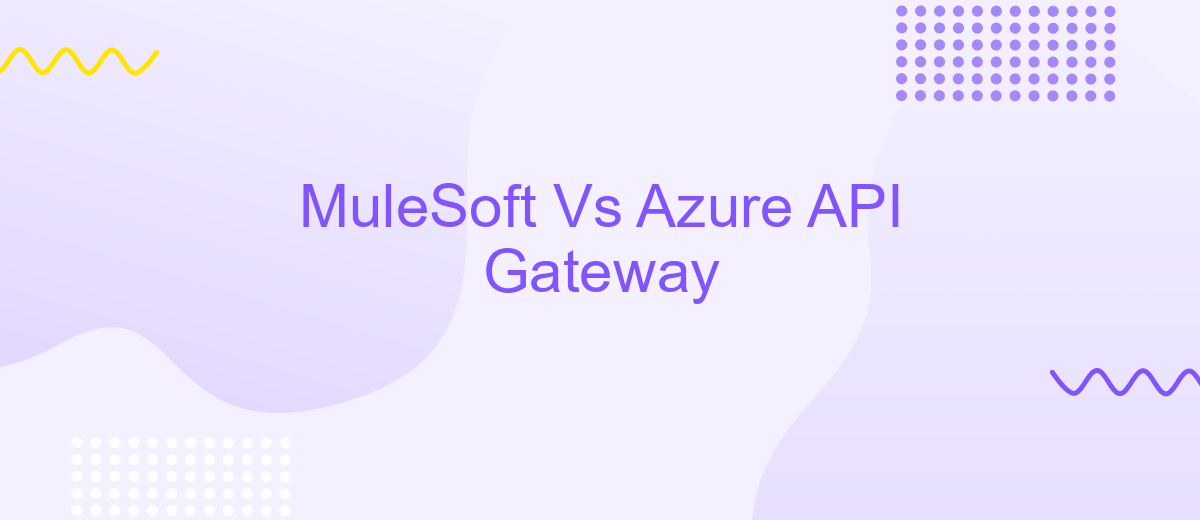MuleSoft Vs Azure API Gateway
In the rapidly evolving landscape of API management, choosing the right platform is crucial for seamless integration and performance. This article delves into a comparative analysis of MuleSoft and Azure API Gateway, two leading solutions in the industry. By examining their features, advantages, and use cases, we aim to provide valuable insights to help you make an informed decision for your business needs.
Introduction
In today's digital landscape, the need for efficient API management has become crucial for businesses to streamline their operations and enhance connectivity. Two prominent solutions in this domain are MuleSoft and Azure API Gateway. These platforms offer robust features that cater to diverse integration needs, enabling seamless communication between various systems and applications.
- MuleSoft: Known for its comprehensive Anypoint Platform, MuleSoft provides extensive tools for API design, development, and management.
- Azure API Gateway: Part of the Microsoft Azure ecosystem, this service ensures secure and scalable API management within the cloud infrastructure.
Choosing the right API management solution depends on various factors, including specific business requirements, existing IT infrastructure, and future scalability plans. For businesses looking to simplify their integration processes, services like ApiX-Drive can be a valuable addition, offering automated workflows and seamless connectivity between different applications. Understanding the strengths and limitations of each platform will help organizations make an informed decision that aligns with their strategic goals.
Features Comparison

MuleSoft offers a comprehensive set of features for API management, including API design, development, and analytics. It provides robust tools for creating, deploying, and managing APIs with ease. MuleSoft's Anypoint Platform allows seamless integration with various third-party services and applications, enhancing its flexibility and scalability. Additionally, MuleSoft supports advanced security protocols and offers detailed analytics to monitor API performance and usage.
Azure API Gateway, on the other hand, excels in its native integration with other Microsoft Azure services, making it a preferred choice for enterprises already invested in the Azure ecosystem. It offers features like API versioning, throttling, and request/response transformation. Azure API Gateway also provides built-in security features and detailed analytics. For those looking to streamline integrations, services like ApiX-Drive can be leveraged to automate data transfer and synchronization between different applications, complementing the capabilities of both MuleSoft and Azure API Gateway.
Pricing

When it comes to pricing, MuleSoft and Azure API Gateway offer different models tailored to various business needs. MuleSoft operates on a subscription-based model, where pricing is determined by the number of cores and the level of support required. This model can be quite flexible, allowing companies to scale their usage according to their growth and integration needs.
- MuleSoft: Subscription-based pricing dependent on cores and support levels.
- Azure API Gateway: Pay-as-you-go model based on the number of API calls and data transfer.
- ApiX-Drive: Offers affordable, subscription-based plans for easy integration setup.
Azure API Gateway, on the other hand, uses a pay-as-you-go pricing model, where costs are calculated based on the number of API calls and the amount of data transferred. This can be more cost-effective for smaller projects or businesses with variable API usage. Additionally, services like ApiX-Drive can complement these platforms by offering straightforward, subscription-based plans that simplify the integration process, making it easier to manage costs and streamline operations.
Pros and Cons

When comparing MuleSoft and Azure API Gateway, it's essential to consider their unique strengths and weaknesses. MuleSoft is renowned for its robust integration capabilities, making it an excellent choice for enterprises with complex integration needs. On the other hand, Azure API Gateway is deeply integrated with the Azure ecosystem, providing seamless connectivity for applications hosted on Azure.
One of the significant advantages of MuleSoft is its comprehensive support for various protocols and data formats, which is crucial for businesses dealing with diverse systems. Azure API Gateway excels in scalability and ease of use, especially for organizations already leveraging Azure services.
- MuleSoft Pros: Extensive integration capabilities, support for multiple protocols, strong data transformation features.
- MuleSoft Cons: Higher cost, steeper learning curve.
- Azure API Gateway Pros: Seamless Azure integration, scalability, cost-effective.
- Azure API Gateway Cons: Limited to Azure ecosystem, fewer integration features compared to MuleSoft.
For businesses looking to streamline their integration processes, tools like ApiX-Drive can also be considered. ApiX-Drive offers a user-friendly platform to automate data transfer between different applications, complementing the capabilities of both MuleSoft and Azure API Gateway. Ultimately, the choice between MuleSoft and Azure API Gateway depends on the specific needs and existing infrastructure of the organization.
Conclusion
In conclusion, both MuleSoft and Azure API Gateway offer robust solutions for managing and securing APIs, but they cater to different needs and preferences. MuleSoft is particularly strong in providing a comprehensive integration platform that supports a wide range of connectors and tools, making it ideal for complex enterprise environments. On the other hand, Azure API Gateway excels in seamless integration with other Azure services, offering a highly scalable and secure solution for organizations already invested in the Azure ecosystem.
When choosing between these two platforms, it is crucial to consider your specific requirements, existing infrastructure, and long-term goals. For businesses seeking a versatile and user-friendly integration service, ApiX-Drive can also be a valuable addition to streamline the process of connecting various applications and services. Ultimately, the best choice will depend on the unique needs of your organization and the specific capabilities you require from an API management solution.
- Automate the work of an online store or landing
- Empower through integration
- Don't spend money on programmers and integrators
- Save time by automating routine tasks
FAQ
What are the primary differences between MuleSoft and Azure API Gateway?
Which platform is better for a multi-cloud strategy?
How do MuleSoft and Azure API Gateway handle API security?
Can I use MuleSoft or Azure API Gateway for automating and setting up integrations?
Which platform offers better monitoring and analytics capabilities?
Routine tasks take a lot of time from employees? Do they burn out, do not have enough working day for the main duties and important things? Do you understand that the only way out of this situation in modern realities is automation? Try Apix-Drive for free and make sure that the online connector in 5 minutes of setting up integration will remove a significant part of the routine from your life and free up time for you and your employees.


